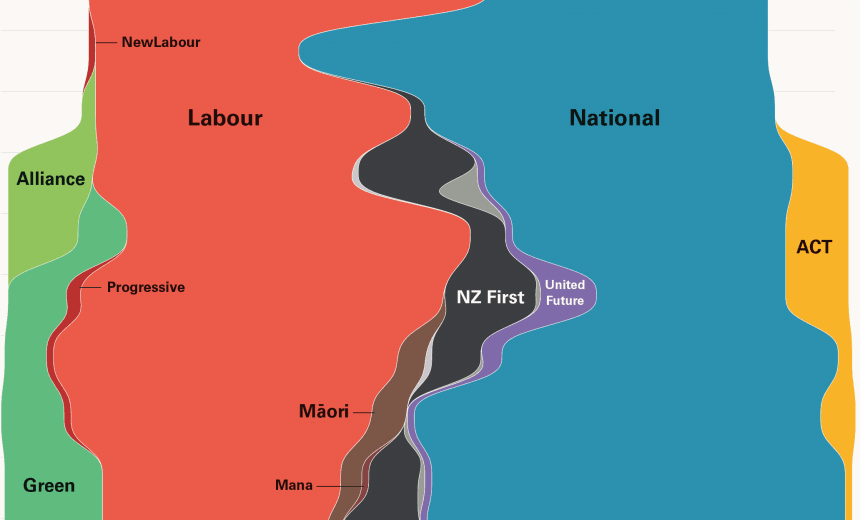Chris McDowall explains the origins of this epic graph view into our political history.
This post was first published September 14, 2017.
For months I’ve followed news about New Zealand’s upcoming general election. Revelations! Resignations! Leadership changes! Bold policy promises! Shock poll results!
In this heightened political moment, I found myself wondering about the past. How does this election fit into New Zealand’s political history? What would it look like if you mapped parliamentary representation back to our first election in 1853?
Wondering led to reading. Soon I fell down a rabbit hole of Te Ara entries, Electoral Commission results and Wikipedia pages. I compiled spreadsheets of elections, by-elections and changes in party affiliation. Eventually I had gathered enough statistics to create a stream graph with designer Tim Denee, showing how many MPs each party had through history.
In the following graphic, time starts in the year 1853 and advances down the page. Blocks of colour represent political parties. The wider a block, the more MPs the party had in parliament at that time.
In parliament’s early years, political parties were local organisations rather than national bodies. Until the late 19th century, there were no political parties as we would recognise today. Members formed factions, but arrangements were loose.
The establishment of the Liberal Party in 1891 signalled the start of party politics. Over several decades parties formed, evolved, merged and disappeared. The oppositional conservative factions became the Reform Party. Labour and Social Democrat parties were founded, then merged into the modern Labour Party. The Liberal became the United Party. United formed a governing coalition in 1931 with Reform, before merging into the modern National Party in 1936.
Like today, it was complicated.
Then things stabilised. For over half a century the National and Labour parties dominated the nation’s politics. Social Credit got an MP elected in the late 1960s and another two in the late 1970s. Otherwise it was a two-horse race. This started to change when Jim Anderton split from Labour in 1989, creating NewLabour. In 1993 the Alliance and New Zealand First each got two members elected to parliament.
New Zealand switched from first-past-the-post voting to a mixed-member proportional system in 1996. The political landscape became far more fluid. Eight small political parties gained parliamentary representation alongside the two major players. As the smaller parties got members into parliament, Labour and National could no longer hold enough seats to govern alone. This is an age of coalitions, diverse voices and shifting sands.
Thanks to Philip Lyth and Keitha Booth for providing feedback on drafts of this diagram. All mistakes are my own.
